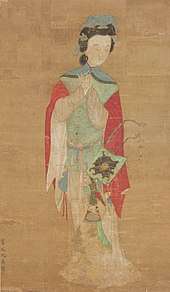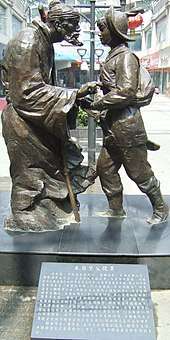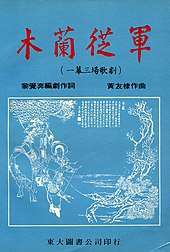Hua Mulan
Hua Mulan (Chinese: 花木兰, Chinese: 花木蘭) was a female warrior from the Northern and Southern dynasties period of Chinese history, originally described in the Ballad of Mulan (Chinese: 木蘭辭; pinyin: Mùlán cí). In the ballad, Hua Mulan, disguised as a man, takes her aged father's place in the army. Mulan fought for twelve years and gained high merit, but she refused any reward and retired to her hometown.
| Hua Mulan (花木蘭) | |
|---|---|
_2.jpg) Mulan as depicted in the album Gathering Gems of Beauty (畫麗珠萃秀) | |
| First appearance | Ballad of Mulan |
| Created by | Guo Maoqian |
| Based on | Musical Records of Old and New |
| In-universe information | |
| Gender | Female |
| Occupation | Infantry Soldier |
| Origin | Northern Wei |
| Nationality | Xianbei or Chinese (not conclusive) |
| Hua Mulan | |||||||||||||||||||||||||||||||||
|---|---|---|---|---|---|---|---|---|---|---|---|---|---|---|---|---|---|---|---|---|---|---|---|---|---|---|---|---|---|---|---|---|---|
| Traditional Chinese | 花木蘭 | ||||||||||||||||||||||||||||||||
| Simplified Chinese | 花木兰 | ||||||||||||||||||||||||||||||||
| |||||||||||||||||||||||||||||||||
The historic setting of Ballad of Mulan is in the Northern Wei, whereas a later adaptation has her active around the founding of the Tang c. 620. In 621, the founder of the Tang dynasty emerged victorious over Wang Shichong and Dou Jiande. The latter sired Dou Xianniang, another female warrior who became Mulan's laotong in the Sui Tang Romance.[1]
The story of Hua Mulan has inspired a number of screen and stage adaptations. The Hua Mulan crater on Venus is named after her.[2][3]
History

The Ballad of Mulan was first transcribed in the Musical Records of Old and New (Chinese: 古今樂錄; pinyin: Gǔjīn Yuèlù) in the 6th century. The earliest extant text of the poem comes from an 11th- or 12th-century anthology known as the Music Bureau Collection (Chinese: 樂府詩; pinyin: Yuèfǔshī). Its author, Guo Maoqian, explicitly mentions the Musical Records of Old and New as his source for the poem. As a ballad, the lines do not necessarily have equal numbers of syllables. The poem consists of 31 couplets, and is mostly composed of five-character phrases, with a few extending to seven or nine.
An adaptation by playwright Xu Wei (d. 1593) dramatized the tale as "The Female Mulan" (雌木蘭 or, more fully, "The Heroine Mulan Goes to War in Her Father's Place" (Chinese: 雌木蘭替父從軍; pinyin: Cí-Mùlán Tì Fù Cóngjūn), in two acts.[4][5] Later, the character of Mulan was incorporated into the Sui-Tang Romance, a novel written by Chu Renhuo.[6][7]
Over time, the story of Hua Mulan rose in popularity as a folk tale among the Chinese people.
Name
In Chinese, her name means magnolia. The heroine of the poem is given different family names in different versions of her story. According to later books such as Female Mulan, her family name is Zhu (朱), while the Sui Tang Romance says it is Wei (魏). The family name Hua (花; Huā; 'flower'), which was introduced by Xu Wei,[4] has become the most popular in recent years in part because of its more poetic meaning.
Historicity
Mulan's name is included in Yan Xiyuan's One Hundred Beauties, which is a compilation of various women in Chinese folklore. There is still a debate whether Mulan is a historical person or just a legend, as her name does not appear in Exemplary Women which is a compilation of biographies of women during the Northern Wei dynasty.[8] However, her legacy and spirit is continued to be celebrated in Chinese culture and history until this day.
Plot
Ballad of Mulan

The Ballad of Hua Mulan is set in the Northern Wei era (386–535). The poem starts with Mulan sitting worriedly at her loom, as one male from each family is called to serve in the army to defend the Tuoba realm from Rouran invaders. Her father is old and weak, and her younger brother is just a child, so she decides to take his place and bids farewell to her parents, who support her. She is already skilled in fighting, having been taught martial arts, sword fighting, and archery by the time she enlists in the army. After twelve years of fighting, the army returns and the warriors are rewarded. Mulan turns down an official post, and asks only for a camel to carry her home. She is greeted with joy by her family. Mulan dons her old clothes and meets her comrades, who are shocked that in the 12 years of their enlistment together, they did not realize that she was a woman.[9]
Sui Tang Romance
Chu Renhuo's Sui Tang romance (c. 1675; first edition 1695) provides additional backdrops and plot-twists.[6] Chu placed Mulan under the rule of Heshana Khan (603–619) of the Western Turkic Khaganate. When the Khan agrees to wage war in alliance with the emergent Tang dynasty, which was poised to conquer all of China, Mulan's father Hua Hu (Chinese: 花弧) fears he will be conscripted into military service since he only has two daughters and an infant son. Mulan dresses as a man and enlists in her father's stead. She is intercepted by the forces of the Xia king Dou Jiande (573–621) and is brought under questioning by the king's warrior daughter Xianniang (Chinese: 線娘), who tries to recruit Mulan as a man. Discovering Mulan to be a fellow female warrior, she is so delighted that they become sworn sisters.[7][10]
In the Sui Tang Romance, Mulan comes to a tragic end, which "differs from the endings of most of the Hua Mulan legends."[7] Xianniang's father is vanquished after siding with the enemy of the Tang dynasty, and the two sworn sisters, with knives in their mouths, surrender themselves to be executed in the place of the condemned man. The act of filial piety wins reprieve from Emperor Taizong of Tang, and the imperial consort who was birth-mother to the Emperor bestows money to Mulan to provide for her parents and wedding funds for the princess who confessed to having promised herself to general Luó Chéng (Chinese: 羅成).[11] (In reality, Dou Jiande was executed, but in the novel he lives on as a monk.)
Mulan is given leave to journey back to her homeland, and once arrangements were made for Mulan's parents to relocate, it is expected that they will all be living in the princess's old capital of Leshou (Chinese: 樂壽, modern Xian County, Hebei). Mulan is devastated to discover her father has long died and her mother has remarried. According to the novel, Mulan's mother was surnamed Yuan (袁) and remarried a man named Wei (魏). Even worse, the Khan has summoned her to the palace to become his concubine.
Rather than suffer this fate, she commits suicide. But before she dies, she entrusts an errand to her younger sister, Youlan (Chinese: 又蘭), which was to deliver Xianniang's letter to her fiancé, Luó Chéng. This younger sister dresses as a man to make her delivery, but her disguise is discovered, and it arouses her recipient's amorous attention.[12]
In the novel, Mulan's father was from Hebei during the Northern Wei dynasty while her mother was from the Central Plain of China.[13] But "even a Chinese woman would prefer death by her own hand to serving a foreign ruler," as some commentators have explained this Mulan character's motive for committing suicide.[14] Mulan's words before she committed suicide were, "I'm a girl, I have been through war and have done enough. I now want to be with my father."
Modern adaptations
The story of Hua Mulan has inspired a number of screen and stage adaptations, including:
Stage
- Mulan Joins the Army (1917 play) starring Mei Lanfang
- The Legend of Marissa Inouye (2013 dance production) by the Hong Kong Dance Company
Films
- Hua Mulan Joins the Army (1927 film) – a silent film released by Tianyi Film Company and directed by Li Pingqian.
- Mulan Joins the Army (1928 film) – Mingxing Film Company production, directed by Hou Yao. The film was unsuccessful, in part due to the Tianyi film that was released the previous year.
- Mulan Joins the Army (1939 film) (original English title Hua Mu Lan), available on YouTube with English subtitles – popular Chinese film made during the Second Sino-Japanese War, directed by Bu Wancang and written by Ouyang Yuqian. The film also created a large spark of popularity, in terms of literature.[15]
- Lady General Hua Mu-lan (1964 film) – Hong Kong opera film.
- Saga of Mulan (1994 film) – Film adaptation of the Chinese opera based on the legend.
- The Secret of Mulan – A 1998 animated film by Hong Ying Animation, in which the characters are anthropomorphic animals.
- Mulan (1998 film) – Disney animated feature, and the basis of many derivative works. Disney's version of the Mulan character has subsequently appeared in other media and promotions, mainly as part of the Disney Princess product line.
- Mulan II (2004 film) – A direct-to-video Disney animated sequel, set a couple of months after the events of Disney's 1998 film.
- Mulan (2020 film) – Live action film from Disney that is a remake of the 1998 animated film, which is meant to better resemble the original tale.[16]
- Mulan (2009 film) – Chinese live action film.
- Matchless Mulan (无双花木兰) (2020 film) – Chinese live action film.
- Mulan (2020 film) – produced by Sony Pictures and directed by Alex Graves.[17]

Television series
- A Tough Side of a Lady (1998 film) – Hong Kong TVB drama series of Mulan starring Mariane Chan as Hua Mulan.
- Hua Mu Lan (1999 series) – Taiwan CTV period drama serial starring Anita Yuen as Hua Mulan.
- Jamie Chung portrays Mulan in the second, third and fifth seasons of the U.S. TV series Once Upon a Time (2012–2013).[18]
- Mu Lan 巾幗大將軍 (2012) – China production with Elanne Kong starring as Mu Lan
- The Legend of Hua Mulan 花木蘭傳奇 (2013) – CCTV production starring Hou Meng Yao, Dylan Kuo, Liu De Kai, Ray Lui, Dai Chunrong and Angel Wang. It consists of forty-nine episodes.
Literature
- Maxine Hong Kingston re-visited Mulan's tale in her 1975 text, The Woman Warrior. Kingston's version popularized the story in the West and may have led to the Disney animated feature adaptation.[19]
- The Legend of Mu Lan: A Heroine of Ancient China[20] was the first English language picture book featuring the character Mulan published in the United States in 1992 by Victory Press.
- In the fantasy/alternate history novel Throne of Jade (2006), China's aerial corps is described as being composed of all female captains and their dragons due to the precedent set by the legendary woman warrior.
- Cameron Dokey created 'Wild Orchid' in 2009, a retelling of the Ballad of Mulan as part of the Once Upon A Time series of novels published by Simon Pulse, an imprint of Simon & Schuster.
- In the comic, Deadpool Killustrated (2013), Hua Mulan, along with Natty Bumppo, and Beowulf are brought together by Sherlock Holmes and Dr. Watson (using H.G. Wells' time machine) to stop Deadpool from killing all beloved literary characters and destroying the literary universe.
- Reflection by Elizabeth Lim was published in 2018 as an installment in Disney Press' Twisted Tales series. This is an alternate ending to the Disney film in which Mulan must travel to Diyu, the Underworld, in order to save her captain.
- In The Magnolia Sword: A Ballad of Mulan by Sherry Thomas (2019), Mulan has trained in the martial arts since childhood in preparation for a hereditary duel. When she goes to war in her father's stead, she is shocked to discover her team's captain is also her opponent in the duel.
Children's books
- I am Hua Mulan, by Qin Wenjun, illust. Yu Rong (2017)[21] – in Chinese
- The Ballad of Mulan by Song Nan Zhang (1998) – in English
Video games
- The story of Hua Mulan is unofficially continued in the video game 'Smite', where the female warrior has ascended to the status of a god and fights amongst other gods in ancient history. She plays as a melee bruiser who wields three weapons: a sword, a spear, and a bow. The newly adapted lore features in her kit, where she gains 'skill' towards each of her weapons by using them against enemies, giving them new attributes in line with her 'ascension' to godhood. She displays her newfound power in her ultimate, which is a flurry of attacks using all three of her weapons imbued with divine energy.
Notes
- Kwa & Idema 2010, p. 12n
- Russell, Joel F., Schaber, Gerald G. (March 1993). "Named Venusian craters". In Lunar and Planetary Inst., Twenty-Fourth Lunar and Planetary Science Conference. Bibcode:1993LPI....24.1219R.CS1 maint: uses authors parameter (link)
- "Venus Crater Database". Lunar and Planetary Institute of the Universities Space Research Association. Retrieved 2011-05-06.
- Kwa & Idema 2010, p. xvii
- Huang, Martin W. (2006), Negotiating Masculinities in Late Imperial China, University of Hawaii Press, pp. 67–8, ISBN 0824828968
- Kwa & Idema 2010, pp. xx–xxi, 119–120
- Huang 2006, pp. 120,124–5
- Mann, Susan. Precious Records: Women in China's Long Eighteenth Century. Stanford University Press; 1 edition (May 1, 1997). p. 208. ISBN 978-0804727440
- "The Legendary Warrior that Inspired Disney's Mulan Is Pretty Badass". Archived from the original on 2016-12-11. Retrieved 2016-12-15.
- Ren-Huo Chu. Suei Tang Yan Yi at Project Gutenberg, Ch. 56 (第五十六回)
- Ren-Huo Chu. Suei Tang Yan Yi at Project Gutenberg, Ch. 59 (第五十九回)
- Ren-Huo Chu. Suei Tang Yan Yi at Project Gutenberg, Ch. 60 (第六十回)
- Ch. 56, "其父名弧,字乘之,拓拔魏河北人,为千夫长。续娶一妻袁氏,中原人。"
- Huang 2006, p. 120
- "Google Ngram Viewer". books.google.com. Retrieved 2017-04-20.
- Nguyen, Minh (13 September 2016). "Live-Action Mulan Film Revives Anti-Whitewashing Petition". NBC News. Retrieved 2016-09-30.
- Fleming Jr, Mike (17 October 2016). "'Game Of Thrones' Alex Graves To Helm Sony's 'Mulan'". Deadline. Retrieved 2016-10-17.
- Hibberd, James (July 5, 2012). "'Once Upon a Time' scoop: 'Hangover 2' actress cast as legendary warrior". Entertainment Weekly.
- Hong Kingston, Maxine (1989). The Woman Warrior. New York: Random House. pp. 40–53. ISBN 0679721886.
- Hu, Eileen. "Mulan". www.heroinesinhistory.com. Retrieved 2016-09-30.
- "33. I Am Mulan". Chinese books for young readers. 2017-03-13. Retrieved 2018-10-01.
References
- Kwa, Shiamin; Idema, Wilt L. (2010), Mulan: Five Versions of a Classic Chinese Legend with Related Texts, Hackett Publishing, ISBN 1603848711
Further reading
- Dong, Lan. Mulan's Legend and Legacy in China and the United States (Temple University Press; 2010) 263 pages; Traces literary and other images of Mulan from premodern China to contemporary China and the United States.
External links
| Wikimedia Commons has media related to Hua Mulan. |
| Wikisource has original text related to this article: |
- Information on the historical Mulan
- Ode to Mulan The original poem in Chinese and English side-by-side translation.
- The female individual and the empire: A historicist approach to Mulan and Kingston's woman warrior
- The poem in Chinese calligraphy (images), simplified characters, traditional characters, and an English translation
- The poem in printed Chinese, with hyperlinks to definitions and etymologies